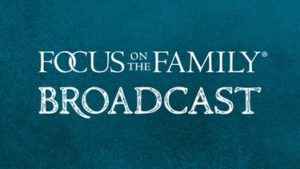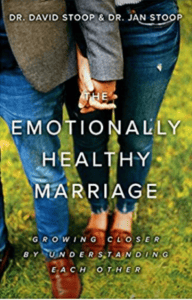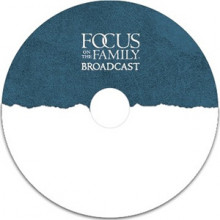Excerpt:
Dr. David Stoop: And he said, well, I think – I said, don’t tell me what you think. Tell me what you feel. He couldn’t. He couldn’t say a word. And so I started through a list of feelings. Do you feel this? Do you feel this? And he could think a minute and say yes and say no. And his wife, all of a sudden, stopped crying. She said, you mean, he has emotions. And he just didn’t have the language for emotions.
End of Excerpt
John Fuller: That’s Dr. David Stoop. And he’s with us along with his wife Dr. Jan Stoop. And this is Focus on the Family. Your host is Focus president and author Jim Daly. I’m John Fuller. And today, we’re going to be sharing some really good groundbreaking ideas for a lot of couples.
Jim Daly: We are, John. We’re going to hear about emotional intelligence. And I’m sure you’ve heard of that. It’s usually used in a business context – how good do you get along with your work colleagues. And how do you climb the ladder? But this couple has applied it to marriage and in a Christian context. And I think that is a wonderful way to look at the way God has wired us, right? Um, in preparation for this interview, our producer insisted we each take the test, John. So the EQD…
John: Assessment. Let’s not call it a test.
Jim: The assessment, OK.
John: Assessment.
Jim: The assessment. So that’s part of the book…
John: Yes.
Jim: …SMART Love. And, OK, go ahead, fess up.
John: Well, I’m not – I don’t have the emotional intelligence that you do, Jim.
Jim: No, come on, just give your scores.
John: I was about 86, I think.
Jim: I think I…
John: 86.
Jim: …Was 98.
John: And this is on a scale of, like, 120…
Jim: 120…
John: …Right?
Jim: …Yeah.
David: Room for growth.
Jim: Yeah.
John: Yeah.
Jim: There was room for growth.
John: Yeah, I appreciate that.
Jim: You don’t want to be perfect.
David: No.
(LAUGHTER)
Jim: But folks will understand what we’re talking about as…
John: Yeah.
Jim: …We continue to discuss this wonderful concept. And I want to speak to the person who says, but, you know, where is God in all that? God created us. He wired us. He, uh, manufactured the way we think, right? And…
David: He sure did.
Jim: …When you talk about EQ, the godly principles are there –
Jim: Right there in Scripture. In fact, second Timothy 1:7 is one that comes to mind – for God gave us a spirit, not of fear, but of power and love and self-control. That’s part of EQ, isn’t it?
Dr. Jan Stoop: Yeah.
David: That’s right.
Jim: The ability to, uh…
Jan: It’s our goal.
Jim: …Be (unintelligible) and to manage your emotions.
John: And what we’re talking about is knowing yourself, knowing your spouse and growing together. And if you’d like to take that inventory to find out kind of your emotional intelligence in the marriage relationship, we’ll link over to it at focusonthefamily.com/radio.
And our guests, as I said, are Dr. David Stoop. He’s the founder and director of the Center for Family Therapy. And his wife Dr. Jan Stoop is a counselor. And together, they lead marriage seminars and retreats. And they’ve written a book calledSMART Love: How Improving Your Emotional Intelligence– not can –Will Transform Your Marriage.
Jim: Hey, David and Jan, welcome to Focus on the Family.
Jan: Thank you.
David: Our privilege.
Jan: Yeah.
Jim: I’m looking forward to this, uh, in so many ways. How can it help me, today, be a better person? But I love this concept. Now, first of all, you’ve been married 60 years.
David: That’s right.
Jim: So when you’re talking to 20-something, 30-something married couples, do they just, like, drop their jaw and say, you really did that? You married…
David: Yeah.
Jim: …And stayed married for 60…
David: You really lived that long?
Jim: …Years.
(LAUGHTER)
Jim: Even when I did it, we’ve been married 31 years. And they’ll go, wow, how did you do that? But 60 years…
David: Yeah.
Jim: …I’m in awe. And it’s wonderful.
David: Well, it’s interesting. The first 10 years of our marriage, we’ve named it The Great Tribulation. So…
Jim: (Laughter).
David: …We never read the tribulation books because we had already lived through The Great Tribulation.
Jim: (Laughter).
David: We – we got married very young, and we didn’t know much about relationships. And it was a tough time, but we stayed the course. And I have couples come in, married five years, and they’re in difficulty. And I say, well, you got maybe five more years to go before you just kind of settle in and…
Jim: Five years.
David: Yeah. I don’t know that – I mean, divorce wasn’t in our vocabulary. So it was like…
Jan: That’s one thing…
David: …We had to…
Jan: …We never – we would never speak the word.
David: Yeah, and so…
Jim: Yeah, and that’s good, I mean, foundational.
David: So we would…
Jim: A lot of young couples today need to – to have that same attitude.
David: Yeah, because it takes on a life of its own if you start talking about it (unintelligible).
Jim: That’s so very true. Let’s discuss emotional intelligence. Some people may not have heard of that term and, you know, not read literature about it. What is emotional intelligence? How does it differ from IQ? And just what is it?
David: Well, Daniel Goleman introduced the term in ‘95 in a book calledEmotional Intelligence. And he – he covered the whole spectrum. He covered family relationships and other relationships in the business world. But the business world and Harvard Business Review kind of just grabbed hold of it and ran with it. So it’s only been applied, primarily, in the business world. And it’s been – probably the most important quality that a leader can have is to be strong on emotional intelligence in terms of their leadership. So it has its value been proven in the business world.
Jim: And that’s, uh, different from what we want to talk about. Because where we’re going and your application of those learnings really applies to marriage and to God’s design in marriage, right?
Jan: That’s right.
David: Yeah, we – I got involved in reading everything I could read on it. And every time I’d be reading it, I’d be thinking, this applies to marriage. Why doesn’t somebody do the application? And finally we said, well, let’s do it.
Jim: (Laughter) ‘cause nobody else did.
David: Nobody else was going to do it.
Jim: You know, and I appreciate that. That’s so often what happens. Uh, but in your own marriage, what were those deficits? You referenced them and kind of made light of them. But for us to better understand how you began to say, OK, we aren’t doing things properly, what were those things you were experiencing that lacked EQ?
Jan: Well, we both grew up in Christian homes. And, um, we had that great background. And my folks were the ones who were on their knees every night. And you would think that we would come into a marriage well prepared. But when I said, to Dave, after the first few months, could we pray together? And he said, oh, oh, and…
David: I was very creative with the reasons not to.
Jim: (Laughter). Yeah. Oh…
David: And as our kids came along, I could pray with the family. And I could pray with people – I was an associate pastor at the time – I could pray with people in my office. But to pray just with Jan, oh, that was terrifying.
Jan: I think…
Jim: What made that so difficult?
Jan: I think he was intimidated about what do I say? What…
David: I thought I had to go down deep and reveal the dark side of my personality if I was going to pray with her. That – it was my own problem. I – nobody’s ever said that.
Jim: Right.
David: And I thought I can’t be that open with her because then she’ll reject me.
Jim: Yeah.
David: And about 12-14 years into our marriage, we – I said – I bit the bullet and said, OK, let’s pray together. And we’ve been doing that ever since, every night. And…
Jan: We never miss.
David: …Got us through some terrible times within our family, with one of our kids, and it got us through times with difficulty within the marriage. It’s just been a stabilizing point.
John: But it was a flashpoint until you said OK, I’ll do this.
David: Yeah.
Jan: Uh-uh. And often…
Jim: Yeah.
Jan: …Part of what we like to teach in the seminar is how to get that going – to really understand that it’s not as easy for some, others are – are very fluent in it because they came from it, but to really have a starting point. So we – we talk to them about how to start praying silently holding hands. We just – we go through the whole thing. And it’s usually the men who are holding back. But that’s – that’s not always true. But…
Jim: And you think it’s that intimidation, huh?
David: I think so because, uh, women pray with each other at women’s bible studies. Men don’t pray too often at the men’s Bible studies as comfortably.
Jim: Don’t tell the women that.
(LAUGHTER)
David: But it’s a comfort. But I’ve had men complain on the radio calls that – that we do, uh, saying my wife won’t pray out loud with me, and he wants to do it. So there are exceptions. But – but, you know, one of the things that we comment on in the book is, uh, our basic emotional posture, or we call it the BEP. And that was what -that’s what was the problem in the beginning of our marriage. We didn’t understand our emotions. We didn’t understand my instant reaction to any kind of criticism or conflict was to get angry. Because that was my basic emotional posture – was anger. That’s what I’d learned from my father and his anger and his outburst.
And Jan’s was fear. And they complemented – they – if I got angry, she got afraid. And so I would get angry. She’d get afraid and back off, or she’d leave. She would often leave…
Jan: I would actually walk out.
David: …And go for a walk. And I would have – it’d be nighttime. And I’d be worried about her, you know, and…
Jim: Oh, yeah.
David: …Have to go find her.
Jim: And that’s part of it – the SMART concept – that acronym. And we want to dive into that. Butgive us a quick overview of SMART, and then we’ll start to dive a little deeper in each of those.
David: Well, the SMART is an acronym for five facets of what emotional intelligence in a marriage would look like. One – the S is Self-aware of what I feel. And it may be I start to become aware of it after I feel it and after we’ve had the argument. I was angry. I’m sorry. Then I let it grow to the place where I can become aware of what I’m feeling at the time, so I can manage it in that. And the M stands for Managing my emotions. The biblical concept from Timothy there was self-control. One of the fruits of the Spirit is self-control. And so how do I do self-control? Well, I manage what I feel, especially the four negative emotions of anger, fear, shame and sadness. And, uh, then the A – we added the A. And we felt…
John: (Unintelligible), huh?
Jim: Makes a much better word.
David: Yeah, the publisher…
Jim: You need your vowel.
David: The publisher didn’t want to do S-M-R-T.
Jim: Yeah, SMRT.
David: My son said, well, that’s kind of the way that people do things now. But…
Jim: I’m pretty smrt. (Laughter)
David: But they, uh – when – when Goleman first introduced it, he had five assets, and motivation was the one that was eliminated eventually, so we added Accountability – being accountable to myself…
Jim: Oh, that’s good.
David: …Being accountable to my spouse and being accountable to other couples and how important that is. Uh, and then the R is Reading my spouse’s emotions, which is a way of saying, I have empathy. And I can read her emotions because I’ve developed my own self-awareness and managing my own emotions. And I’m comfortable now with my own feelings. And so I can be comfortable in reading and interpreting her feelings.
Jim: Right. And we’re going to get into each of these more in just a minute . But let’s get T. We got SMAR.
David: T is Together in the land of emotion. We talk – I talk about the land of emotions, uh, in the beginning the book. And so T means that we’re Together. We’re comfortable to – in – with our emotional world now equally.
Jim: Boy, that’s a big one, too…
John: That’s a big one, too, yeah.
Jim: …Being comfortable in the land of emotions.
David: Those are consequences. The R and the T are consequences of my developing the S and the M and the A.
Jim: Let’s go back, before we get into the SMART acronym more deeply, the negative emotions you touched on – anger, fear, sadness, shame.
David: Well, the – all of the emotional theorists agree that there are six basic emotions. They…
Jim: Yeah.
David: Uh, anger, fear are common. And then sometimes they use disgust. But disgust doesn’t fit what I’m doing. So I went with the others who use shame and sadness. And then there’s joy. And there’s surprise. And joy and surprise…
Jan: So we concentrate on the first four because that’s the issue. That’s where the problems come.
David: Yeah.
Jan: Yeah.
David: You don’t get in trouble with it because you’re too joyful or…
John: Oh, I don’t know, sometimes I surprise my wife, and she didn’t really like that…
David: Well…
John: …A whole lot.
(LAUGHTER)
David: …Maybe it was the motivation behind the surprise.
John: That could be it, yeah.
(LAUGHTER)
Jim: Now, you’re finding and have found over the years that you’ve done this that men are typically going to struggle a bit more with the concepts, uh, moreso than women. Why is that?
David: Well, it’s not that men don’t have emotions, although their wives are convinced they don’t have any emotions, you know. I had a couple in my office where she was extremely angry. I always said that the doorframe around my – the door of my office charred when she walked through it…
John: Oh, my.
Jim: Oh, man.
David: …The heat of her anger, you know. Then she sat there with her arms folded and just stared at me. And I said, you’re very angry, aren’t you? And she says, how astute.
(LAUGHTER)
David: But I – she was talking, and she started crying, really crying heavily. And I turned to him, and I said, what are you feeling right now as you watch your wife feel so pained?And he said, well, I think – I said, don’t tell me what you think. Tell me what you feel. He couldn’t. He couldn’t say a word. And so I started through a list of feelings. Do you feel this? Do you feel this. And he could think a minute and say yes and say no. And his wife, all of a sudden, stopped crying. She said, you mean, he has emotions. And he just didn’t have the language for emotions.
Jim: Right.
David: But he could help. So we have a – we have a chart in the book of the four negative emotions. And I think there’s nine sub feelings that go under it.
Jim: Descriptions.
David: Descriptions of that emotion – how we might characterize it. And I suggest that you take it and laminate it and carry it with you if you’re a man.
Jan: Well…
Jim: And it’s a great idea. And I was even thinking about that. I think we do not connect these dots very well, as men.
David: No, we…
Jim: We will say we feel angry. But then what does that really mean? And, in fact…
David: The only emotion we are aware of.
Jim: Yeah. And let me just read some of those descriptors. Because even as I was prepping for the show…
Jan: Well, that’s important…
Jim: …It helped.
Jan: …To see – yeah.
Jim: It helped me go, oh, that’s the label. But under anger, it’s furious, enraged, uh, irate, seething, upset, frustrated, annoyed, irritated, touchy. I mean, that – that…
David: Yeah.
Jim: …Gives some substance…
Jan: All under…
Jim: …To that.
Jan: …Anger.
Jim: Yeah. I found that to be really helpful because I – it’s multi-dimensional.
David: Because I can look at the chart and say, well, this was that feeling. That goes under the rubric of fear or shame or what – or sadness. You know, unworthy is a sadness.
Jim: So I think women are far more adept at connecting to those descriptors than we are.
Jan: Yeah.
Jim: It’s innate for them. They know how to do it.
David: But they don’t…
Jim: We’re kind of lost.
David: They don’t know how to do it with their husband.
Jim: Yeah.
David: And so…
Jan: Well, yeah, oftentimes, they feel like, we’ll just make things worse if we – if we talk about our emotion, what we’re feeling. And it goes by. Then the time goes by, and they don’t really get to share with him because they’re afraid. And many women have deep emotions – of course, they do.
David: And they share them with their lady friends…
Jan: Yeah, they might share them with their – or my prayer partner or whatever.
Jim: Because they understand…
Jan: Yeah.
Jim: They understand it.
David: That’s right.
Jim: My husband doesn’t understand me, which is pretty true.
David: That’s when she withdraws. And there’s a way to express it. And to get him to understand the language is a big help.
John: Our guests today on Focus on the Family are Dr. David Stoop and his wife Dr. Jan Stoop, and we’re talking about some of the concepts in their book SMART Love: How Improving Your Emotional Intelligence Will Transform Your Marriage. And, uh, we’ve got the book and a link over to that assessment tool that we described earlier, and a CD or a download of our program at focusonthefamily.com/radio.
Jim: Let me ask you a more fundamental question – why is it so scary or intimidating for us, in our marriages, to be vulnerable that way? You would think that, particularly with Christian marriages, that we would want to understand each other as best as we could, to learn about each other, to have a smart love, as your book is titled. But even in Christian marriages, we pull back. We hide. We don’t let the other person in – the spouse that we know and love so much.
David: Well, we can do it before we’re married to some degree.
David: Right, and it’s attractive.
Jan: Yeah.
David: Yeah. And then, all of a sudden, the person that we were going to marry disappears, and the real person comes at the wedding. And then it all changes. It changed for us. The – just as the ceremony was over, it was like, I was a different person.
Jim: In what way? Just give us some descriptors.
David: I became more controlling and less understanding because I was – you know, I – like I said, I was young. I was immature. I didn’t understand. I think it has a lot to do with maturity. But it has to do with self-acceptance. Because there’s a sense in which my feelings are the closest part of me to my soul. And that’s the most vulnerable place that I have is when I get emotional. So a guy’ll cry in a movie, but he’s got to be so sure and clear up his eyes before the lights come back on.
Jim: That’s for sure.
David: And it’s OK. He might allow himself to do that. But to talk about it with his wife afterwards, that’s weak. And we often define that as weak, too, which makes it difficult.
Jim: Yeah. Jan, how about for you, as the wife? And you – I don’t know if you saw that right away – that change at the altar, so to speak.
Jan: Well…
Jim: You moved from SMART love to stupid love. And thankfully, you got back to SMART love.
Jan: To me, it felt like, oh, I’ve got you now (laughter).
Jim: Yeah, I’ve got you now, so we’re done. Now this is the real me.
Jan: And so we’re in the real world now. But, um – but a lot of it was triggered by my changes, too, after the marriage. I felt trapped. I felt like I was going to be, um, just overshadowed, or I – it wasn’t important for me to get my degrees or – all those things came about within the fact that…
David: I didn’t know you felt that.
Jim: Here we go right here.
(LAUGHTER)
Jim: Breaking news.
Jan: Uh, but…
Jim: Will they make it to 61?
(LAUGHTER)
Jan: Right. But I think that, um, it took a lot of years for me to feel comfortable, like I was, um, my decisions were important and all those things that a woman wants. They were sort of shadowed because we were – but a lot of it was because we were – we were not on the same page a lot of the time. And both of us were working. We were busy. And then, uh, we had children really quick. And so I think that both of us had a big part in what we did those first 10 years.
David: Yeah.
Jim: Yeah.
David: It does. It’s an interplay between the wife’s fears and the husband’s fears. And we don’t know what to do with our fears at that stage. And so we – we give into them. And that just perpetuates the cycle.
Jim: Well, and so many – again, you’ve been married 60 years. So many couples experience 20, 30 years of hiding. And maybe they continue to just be there and eventually one of them dies.
David: That’s a lonely…
Jan: That’s right.
David: …Feeling.
Jim: And that’s a lonely feeling. And this is the point so many, particularly women, feel lonely in their marriages.
David: That’s why the seven-year itch – the old seven-year itch has become the 37-year-old itch. Because a lot of divorces are taking place in the late thirties. And they’re initiated by the wife…
Jim: Right.
David: …Because she’s fed up with the loneliness.
Jim: And the kids are gone, usually…
David: Kids are gone.
Jim: …Empty nest. And that’s…
David: Yeah.
Jim: …What’s happening. Let’s dive into SMART again. And let’s go a little deeper with each of the acronyms – that’s the goal.
Jan: OK.
Jim: And we’ll get to one or two today. And then we’ll have to come back next time and cover…
Jan: OK.
Jim: …The others. But…
David: OK.
Jim: Let’s start with S. Uh, what does it mean again? And what does that Self-awareness – uh, how’s that defined? And why are so many of us just bad at it? Is it the fall? Is it sin nature? Is – what is it?
David: I think it’s sin…
Jan: I think, as women, we are – we’re bad at it, too. We – you know, I had never ever thought about what kind of, um, category I was in, as far as my emotions, until we started doing something like this. But I had no idea of all the fears that I was working with and coming…
Jim: Women do tend…
Jan: Yeah.
Jim: …To be bound by fear.
Jan: Yeah.
Jim: I mean, it’s…
Jan: And…
Jim: …A general statement, but accurate.
Jan: And so – yeah. So for – for me, uh, that first part, what is so important under the S is that we begin to find our basic emotional posture. And that’s so important – that you start there. Because that’s going to overshadow everything else that you – you do with this…
John: That’s that…
Jan: …S-M-A-R-T.
John: …BEP that you mentioned earlier.
Jim: Basic emotional posture. So define that for us.
Jan: And we call it the BEP – B-E-P (laughter).
Jim: And what…
David: That’s…
Jim: …Does it actually mean?
David: That’s – that’s…
Jim: What is it to be…
Jan: OK.
Jim: …In your basic…
David: That’s my…
Jim: …Posture?
David: …Default position. That’s the place that I go to automatically without even thinking.
Jim: What do those attributes look like?
David: Uh…
Jim: Anger?
David: For me, it would be anger. For Jan, it would be fear. I did a workshop last week, and a guy came up to me afterwards said when you started talking about that, he said, I knew immediately my basic emotional posture was shame because of how he was raised. And then the sadness is the feeling of total unworthiness and hopelessness.
Jan: So there’s four basic – it’s one – going to be…
Jim: Those emotions.
Jan: …One of those…
David: Yeah.
Jan: …To start with.
John: And those are just present. And it takes a little bit of stress maybe or a circumstance. And that…
Jan: And then it comes.
John: …That’s where I go.
David: It gets triggered instantly. And it’s probably comes from the things – people that I’ve experienced growing up or events I experienced growing up. And so there’s an action plan. The first action plan after the SMART…
Jan: Under each one of the S-M-A-R-T we have five action plans…
David: …Ten action plans. And the first one that you come to is to define your emotional posture. And it asks you questions to discuss with your spouse about who represented that emotion when you were growing up, how was it experienced and things like that to try to get at the root of it so that you understand where it comes from. But it’s – it’s like a trigger point and boom, I’m there. I’m acting out that emotion…
Jim: So it’s what – your buttons. What pushes your button. So it’s the button anger or shame or whatever it might be.
David: Yeah, it’s the emotion that’s attached to all of my buttons.
Jan: And then once you decide– or not decide because you don’t have to decide– but – but you realize that you are probably in that category, then I can see all the places that I use that. One of the things – the fears – I got out of my childhood was I was not going to have enough. I wasn’t going to have the right things and all those things because of our losing everything as a child. And um, I realized that I treat him like that. If I see him – uh – carrying something out of the house and I say…
David: Towards the trash can.
Jan: …Are you going to put that in the trash? And I think oh, OK. All right. But I wanted to have some choice in that. And so I can just feel, even subtly, the triggers of fear on things like that even.
Jim: Yeah. You know, one of the difficulties, again, as Christians, I think we can kind of play this down as just a bunch of psychology. But the Lord does encourage us to know our hearts as best we can, to know more accurately who we are because that groundedness allows you to say oh, I’m outside of his will. I’m sinning. You have to have an awareness that you’re in the right spot or you’re not in the right spot. And that’s really what we’re driving at overall, right?
David: Paul says be angry, but don’t sin. So there’s a way to be angry that’s healthy and there’s a way to be angry that’s sinful. And I think that to be true for any of the negative. And there’s a way to be fearful that – that’s…
Jan: That’s appropriate.
David: …Reasonable. That’s appropriate. There’s ways not to. But that be the basic – the reason we want to identify that, that becomes the first emotion that we’re going to – we’re going to learn to manage because that’s the one that gets us in trouble in our marriage and that’s the one that we’ve got to get a handle on and kind of release our buttons so that they’re not so easily triggered.
Jim: We’re going to come back next time and talk more about this, but you used an analogy in your book that puts a smile on my face right now. It’s the Eskimo culture and how young people enter into adulthood. It’s kind of unique. What was it?
David: Well, they had to touch a bear.
Jim: Not just a bear, a polar bear (laughter).
David: They had to touch a polar bear. And basically, what they had to do was face the biggest fear that they would ever live with. And to successfully do that launched you into adulthood. And to not successfully do it kept you from that. It’s like the Old Testament blessing where the father would launch the – uh – him into adulthood by blessing him.
Jim: .. David, in that context, just for some of us who may not see it clearly, what does that do for me? What’s the emotion that it’s pulling out that’s positive, to go up and touch your biggest fear?
David: Well, if I can touch the thing I’m most afraid of, there’s nothing I need to be afraid of anymore. And so I see myself as being competent as an adult…
Jim: So confidence, courage…
David: …Confidence, courage, and…
Jim: …All the brighter sides of emotion.
David: Yeah. And fear grows when we don’t face it. And so we become more afraid if we don’t deal with the fear that we have. And I have a book calledThere’s A Nightmare In My Closetwhere the little boy finally faces this fear that there is a nightmare in the closet. And he turns a light back on after going to bed. And sure enough, there’s this big monster at the bottom of his bed. And he shoots it. And the monster starts crying. And then he tries to get him to stop crying. And finally, he puts him into bed with him and he says I’m sure there’s another monster in my closet, but there’s only room in my bed for one. And it’s a book on fear. And I have adults read it right in my office – it’s a children’s book – because if you face what you’re afraid of, it becomes a crying little baby rather than a scary monster. And so in a sense, I have mastery over the polar bear because I could reach up and touch it and survived it.
Jim: And of course, this all comes back to how you relate to your spouse in your marriage where many people bring their greatest fears, right?
David: Oh, yeah.
Jim: And we’ll talk more about that next time. David and Jan, very thoughtful. I love this idea of taking that kind of research with EQ and applying it to marriages, and I think, particularly, with that Christian lens, to say what is God showing us in the data. We don’t have to fear the data, we just need to better understand it. And I think this has been terrific. So we got the S in SMART. Next time, let’s come back and do MART and get the rest of them. And hopefully, the goal here is to equip you, to be smart in your love. That’s the title of the book,SMART Love.
And we have counselors here who can talk to you and guide you and hopefully even, if you need to, to, you know, link in with somebody nearby you, a counselor who can continue to help you. So don’t hesitate. Give us a call here. That’s why we’re here. Donors make it possible for us to have these counselors available to you. So take advantage of it. And today’s program highlights one of our core fundamentals here at Focus and that is to strengthen marriage. And we believe in this content so much so that for a gift of any amount, we want to send you a copy of David and Jan’s bookSMART Loveso it can help you better communicate with your spouse, whether you’ve been married one year or 60 years like they have. This is good stuff.
John: Get a copy ofSMART Loveand make that generous donation when you contribute online at focusonthefamily.com/radio or call 800, the letter A and the word family, 800-232-6459. And when you donate, in addition to sending you the book as our way of saying thank you, your donation will also be matched dollar for dollar. So your gift will go twice as far. Please, give the gift of family today.
And then take that SMART Love Marriage Assessment Tool that we’ve talked about. Jim and I had the courage to do it–Jim, I was touching my polar bear as I took that (laughter)…
Jim: You were touching your polar bear (laughter).
John: You’ll find all of this at…
Jim: I was running from the polar bear. No I’m kidding.
John: …You’ll find all of this at focusonthefamily.com/radio.
Jim: David and Jan, it’s been great to have you. I just got to say, does it count to go to the zoo to touch the polar bear? Can I just reach through the cage?
David: (Laughter)
Jan: Hardly (laughter).
Jim: You can tell, fear may be one of my problems here. I don’t know. But we’ll cover that next time. Great to have you with us.
Jan: Thank you for having us.
John: And we trust you’ll be with us next time as we are back on Focus on the Family. I’m John Fuller. Your host has been Jim Daly. And join us next time – won’t you? – as we once more help you and your family thrive in Christ.




















